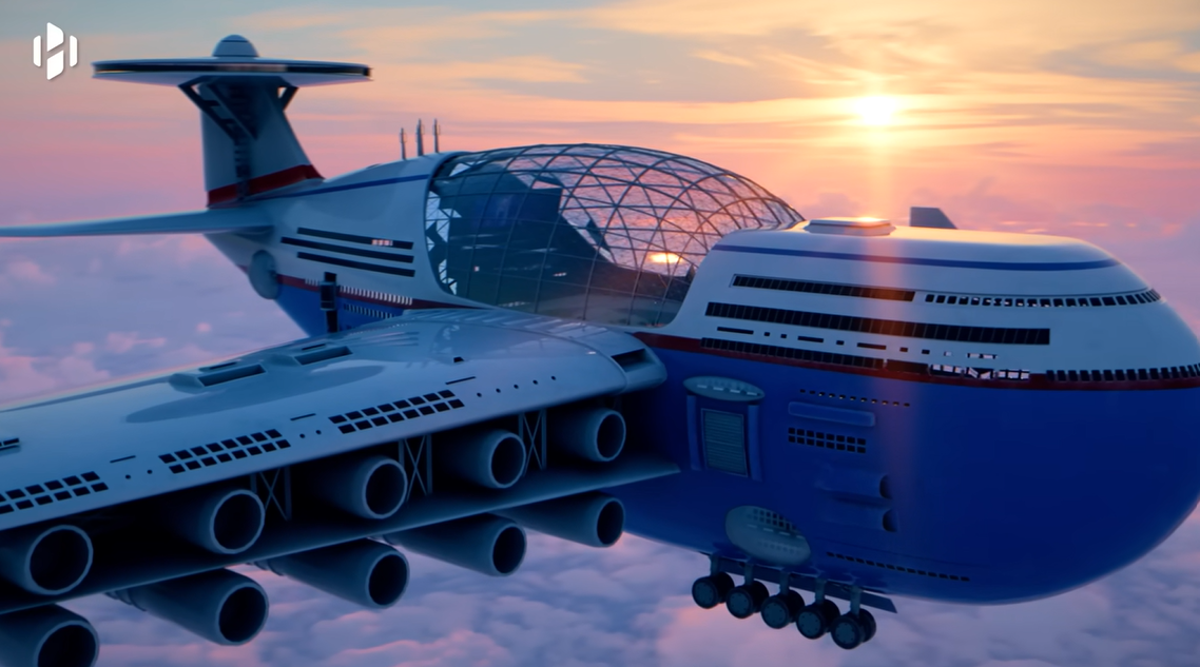Inside the nuclear-powered ‘flying hotel’ that can stay airborne for months

A video showing ambitious designs for a floating “hotel of the future”, which could host 5,000 guests and would remain airborne for years at a time, has divided the internet.
Depicting a hulking jet that looks somewhere between a mega-cruise-ship and a space station floating above the clouds, the CGI video of the “Sky Cruise” vessel was posted by animator Hashem Al-Ghaili on YouTube.
In the description, the designers say the cruiser would be powered by nuclear energy, piloted by artificial intelligence (AI), and have its own disc-shaped observation tower in which passengers could see incredible skyscapes from above the clouds.
The designers claim the floating vessel would stay airborne for years at a time, with passengers and supplies travelling to and from it via electric commercial or private jets, which could land on the top of the cruiser.
The video - with designs by Tony Holmsten and animation by Mr Al-Ghaili - claims Sky Cruise would have no carbon footprint, with 20 electric engines “providing clean, nuclear energy”.
“Thanks to nuclear energy, the hotel never runs out of fuel and can remain suspended in the air for several years without ever touching the ground,” claim designers.
It’s pitched as a leisure holiday destination much like a luxury cruise ship, with the voiceover in the video highlighting multiple bars and restaurants, swimming pools, viewing decks, cinemas and theatres and games rooms - as well as wedding venues on hand for couples to get hitched above the clouds.
Sky Cruise is a concept for a nuclear-powered sky hotel. This video rendering shows the aircraft designed to fly with 20 electric engines, housing over 5,000 guests in nearly nonstop flight [full video, Hashem Al-Ghaili: https://t.co/XN2SFT6PMt] pic.twitter.com/8RrxxtfxYc
— Massimo (@Rainmaker1973) June 26, 2022
As well as steering the ship, the video claims AI would predict and prevent any turbulence, enabling the vessel to “glide over the turbulence with ease”.
However, many science and design fans have slated the idea, with one commenting on YouTube: “If physics and aerodynamics didn’t exist, then this vessel might actually be able to take off.”
Another aviation enthusiast wrote: “I can’t even imagine the amount of maintenence something this massive would need. And how many pilots would you need to fly that thing??”
“Hilarious! It’s like someone got in a time machine, traveled to 2070, found a retrofuturism video based on our era (as opposed to the 1950s or 1800s) depicting what people from our era thought our future would look like,” replied another viewer.
Meanwhile on Twitter, one person mused: “What if we combined the Titanic with the Hindenburg?”
However, some defended the out-there concept, with one YouTube user adding “the creativity behind the idea is wonderful and I hope the planners get somewhere someday!”
Another commented: “Am so jealous for the people of the future.”
It’s not the first techy design for a plane of the future to go viral this year - in April, a Chinese tech company unveiled plans for hypersonic flights which would travel at one mile per second, covering long-haul routes such as Shanghai to New York in two hours.
Beijing Lingkong Tianxing Technology released the animated video showing how its proposed “space flights” might look - with a rocket launcher “boosting” a jet to the edge of space, before separating from it to fly at around 7,000km per hour.

 Yahoo News
Yahoo News 
